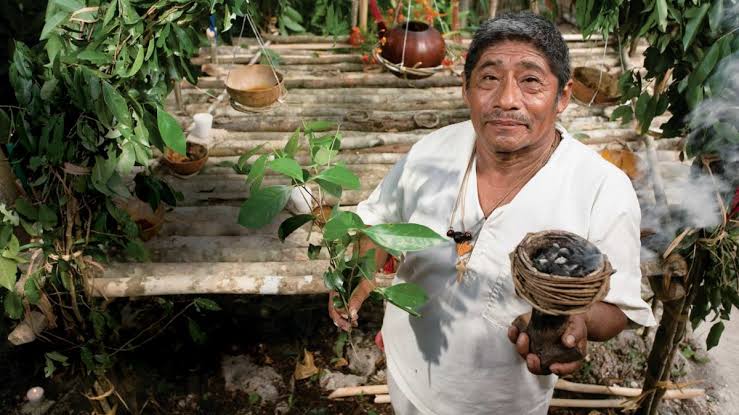Living like any other person in the towns of the contemporary Yucatan, with nothing to indicate that this man, or this woman, whom everyone sees walking by, greeting perhaps some acquaintance, possesses a rich ancestral empirical medical knowledge, capable of curing diseases that allopathic doctors are unable to even diagnose, these people are called “h-meno’ob”, in Mayan language.
These current Mayan healers, both men and women, learned the teachings of their elders as it is a tradition passed down directly from generation to generation.

“H-meno’ob” or healers can also be midwives, although not all of them are. According to Mayan beliefs all of these healers, know both good and evil spirits and all their secrets. Some have chosen to work with the good and heal the negative effects of evil… Other have chosen a darker path. It is this free choice that differentiates the “healers” from the “witches and the sorcerers”.
These men and women of contemporary Maya communities are, culturally speaking, the descendants of the ancient priest heritage that, together with the rulers, held power in the times of the Maya civilization.
The famous and controversial Franciscan chronicler and second bishop of Yucatan, Fray Diego de Landa, points out in his book “Relación de las cosas de Yucatán”, written in the second half of the 16th century, when he speaks of the festivities that the ancient Mayans held, in the month of “Uo”, corresponding to the month of September “the priests, the doctors and the sorcerers, who were all one, began their festivities and celebrations with fasts and other penances. Healers and sorcerers would gather at the house of one of them, with their wives, and the priests… they would unwrap their medicines, their small idol of the goddess of medicine they called Ixchel,… and through prayers they invoked -Ixchel- and the other gods of medicine…” Diego de Landa narrates.

When the conquest occurred and Spanish rule was established, and the antient priest caste was extinguished by the Spaniards, the Mayan people protected and hid these healers, who occupied the last rank in the priestly scale, and who were called since pre-Hispanic times: h-men –Pronounced “jmen”, and means: he who makes, or the maker; the plural is written in Mayan with the ending “o’ob”, thus, the plural of h-men is: h-meno’ob–.
 The Mayan people sheltered the “h-meno’ob” since colonial times, because they had the knowledge to cure illnesses, invoke the gods of nature and the cosmos… or its evil counterpart. As time went by, indigenous medical knowledge was combined and enriched with the medical knowledge of the Spanish, merging into today´s traditional Mayan medicine.
The Mayan people sheltered the “h-meno’ob” since colonial times, because they had the knowledge to cure illnesses, invoke the gods of nature and the cosmos… or its evil counterpart. As time went by, indigenous medical knowledge was combined and enriched with the medical knowledge of the Spanish, merging into today´s traditional Mayan medicine.
Truth is that, Indigenous medicine was very much used by the European colonizers living in the Yucatan Peninsula at that time. As health was quite an issue since in the entire Peninsula at that point in time there were only around 10 doctors .
Today, in these digital and globalized days, Mayan healers are still employed by both indigenous and non-indigenous people.
One of the reasons for this, perhaps the main one, is the integral, warm attention that these Mayan medical practitioners give to the patient, by dealing with both, the emotional and the somatic aspect of the illness.
For some, nothing is more important than the emotional attention and support the healers give to its patients.
For The Yucatan Times
Indalecio Cardeña Vázquez
Merida, Yucatan
January 31st, 2020
 Indalecio Cardeña Vázquez. – Anthropologist, researcher and writer.
Indalecio Cardeña Vázquez. – Anthropologist, researcher and writer.
He has collaborated with the “Unidad Yucatán de la Dirección de Culturas Populares”, Instituto Nacional Indigenista and was the director of the Pinacoteca “Juan Gamboa Guzmán” of the INAH
Among his anthropological works are the iconographic analysis of the colonial sacred art of the Yucatan Peninsula; the symbolisms in the facade of Conquistador Montejo’s house, in Mérida; the Mayan symbolism in the Yucatan Cathedral and the archaeoastronomy among the Mayans.
Professor Cardeña has written several books and articles since the mid 1980’s to this date.



